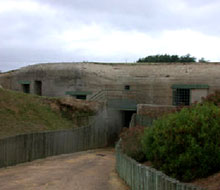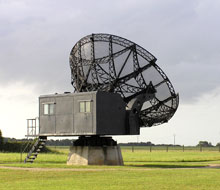Saint-Aubin-sur-Mer
Douvres-la-Délivrande


History
In the evening of 6 June 1944, the Allied Forces had succeeded in gaining a foothold on the beaches of Normandy, and they had established several bridgeheads.
In some places along the coast, local German strong points still resisted. Between Juno Beach and Sword Beach, the defences of Douvres-la-Délivrande kept in check all the Canadian attacks. Douvres-la-Délivrande was an important radar station for air detection; it was defended by many concrete works, armed with guns, machine-guns, and surrounded by minefields. The Germans held the position until 17 June after British/Canadian forces decided on containment of the position.
When a massive attack was launched; the 41st Royal Marine Commando supported by the special armoured, drove the 230 German defenders of the garrison to surrender.
Country of origin: |
Germany |
Introduced: |
1941 |
Number built: |
circa 1500 |
Range: |
up to 70 km (44 mi) |
Diameter: |
7.5 m (24 ft 7 in) |
Azimuth: |
0-360º |
Elevation: |
0-90º |
Precision: |
±15 m (49 ft 2½ in) |
Würzburg radar (German radar station)
The Würzburg radar was the primary ground-based gun laying radar for both the Luftwaffe and the German Army during WWII. Initial development took place before the war, entering service in 1940. Eventually over 4,000 Würzburgs of various models were produced. It took its name from the city of Würtzburg for no other reason than the project leader liked geographical names.
British Royal Marine Commandos
The No. 48 (Royal Marine) Commando was given the task of securing the left flank of the Canadian assault.
They were to land on «Nan Red» sector behind the 8th Brigade and capture Langrune-sur-Mer and as Far East as the divisional boundary. The No. 48 Commando landed at 8.43 am, opposite and immediately east of the Saint-Aubin strongpoint. They suffered heavily from the strong-point's fire and then met stiff opposition in Langrune-sur-Mer.
The No. 41 Commando which landed at Lion-sur-Mer on the 3rd British Infantry Division front, also met difficult enemy resistance. No. 41 Commando was unable to immediately capture Lion-sur-Mer nor capture Le Petit-Enfer to the west. This prevented the units from joining the divisional fronts. It wasn't until June 8th that these towns were captured.
Finally the Commandos helped the Canadians to secure the Radar sites.